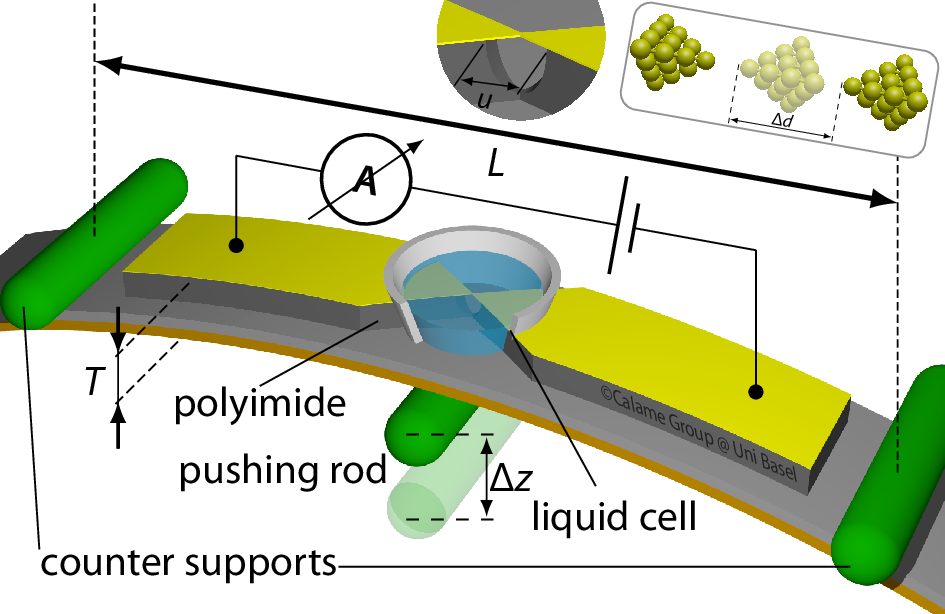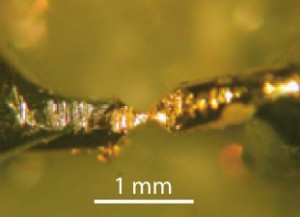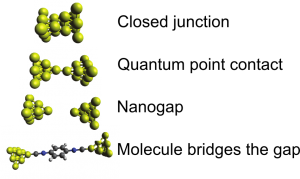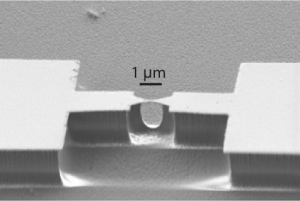
Working principle of MCBJ for liquid measurements. The inset shows the artistic view on the atomically sharp electrodes (formed after the break of the wire) and the relative displacement, corresponding to the displacement of pushing rod.
The mechanically controlled break junction (MCBJ) technique is an approach to contact (electrically) individual molecules. The idea is to fabricate nanocontacts by pulling a ductile metal wire until it narrows down and eventually breaks. Nanocontacts are usually fabricated on the flexible substrate, and the pulling is performed by its controlled bending. The key parameter of such system is an reduction, or attenuation, factor (a = \Delta d/\Delta z) between relative electrode displacement and bending of the substrate. The attenuation factor is defined by the geometry of the sample, and roughly can be estimated using the formula: a = {6uT}/{L^2}, where u is a length of free-standing metallic bridge, T is a thickness of the substrate, and L is a distance between side counter supports.

Historically, the first MCBJ devices were fabricated using notched metallic wire fixed on the substrate with epoxy. Such approach allows very easy fabricate the device without any special equipment, which allows to observe quantized conductance in metallic wires. However, the attenuation factor of notched-wire MCBJ is very small and reaches only about 10^{-2}.
Usage of lithographic techniques to fabricate MCBJ became very important improvement in the field. Towards that end, we prepattern metallic contacts via electron beam lithography on a flexible substrate (typically steel covered with polyimide) which can be placed into a three-point bending mechanism.
For our geometry, this leads to the attenuation factor on the order of 10^{-4}. This allows us to tune the elongation of the wire and the resulting gap after it breaks with sub-angström precision.

Finally, molecules can be added to the system via attaching a liquid cell with molecules in solution. When the wire breaks open, one or more molecules can spontaneously assemble between the contacts to form a molecular junction, which then can be studied using electronic and optoelectronic techniques.

Relevant papers:
-
Vladyka, Anton, Mickael L. Perrin, Jan Overbeck, Rubén R. Ferradás, Víctor García-Suárez, Markus Gantenbein, Jan Brunner, Marcel Mayor, and Jaime Ferrer<em>, et al</em>.
-
Liao, J., S. Blok, S. J. van der Molen, S. Diefenbach, A. Holleitner, C. Schönenberger, A. Vladyka, and M. Calame.
Chem. Soc. Rev. 44 (4) , 999-1014 (2015) .
![[DOI]](../../wp-content/plugins/papercite/img/external.png)
[Abstract]Arrays of metal nanoparticles in an organic matrix have attracted a lot of interest due to their diverse electronic and optoelectronic properties. Recent work demonstrates that nanoparticle arrays can be utilized as a template structure to incorporate single molecules. In this arrangement{,} the nanoparticles act as electronic contacts to the molecules. By varying parameters such as the nanoparticle material{,} the matrix material{,} the nanoparticle size{,} and the interparticle distance{,} the electronic behavior of the nanoparticle arrays can be substantially tuned and controlled. Furthermore{,} via the excitation of surface plasmon polaritons{,} the nanoparticles can be optically excited and electronically read-out. The versatility and possible applications of well-ordered nanoparticle arrays has been demonstrated by the realization of switching devices triggered optically or chemically and by the demonstration of chemical and mechanical sensing. Interestingly{,} hexagonal nanoparticle arrays may also become a useful platform to study the physics of collective plasmon resonances that can be described as Dirac-like bosonic excitations.
-
Brunner, J., Teresa M. González, C. Schönenberger, and M. Calame.
-
Li, Zhihai, Hui Li, Songjie Chen, Toni Froehlich, Christian Schoenenberger, Michel Calame, Silvio Decurtins, Shi-Xia Liu, and Eric Borguet.
-
Nef, Cornelia, Laszlo Posa, Peter Makk, Wangyang Fu, Andras Halbritter, Christian Schönenberger, and Michel Calame.
-
Calame, Michel.
-
Nef, C., P. L. T. M. Frederix, Jan Brunner, C. Schönenberger, and M. Calame.
Nanotechnology 23 , 365201 (2012) .
![[DOI]](../../wp-content/plugins/papercite/img/external.png)
[Abstract]Conducting atomic force microscopy is an attractive approach enabling the correlation of mechanical and electrical properties in individual molecular junctions. Here we report on measurements of gold–gold and gold–octanedithiol–gold junctions. We introduce two-dimensional histograms in the form of scatter plots to better analyze the correlation between force and conductance. In this representation, the junction-forming octanedithiol compounds lead to a very clear step in the force–conductance data, which is not observed for control monothiol compounds. The conductance found for octanedithiols is in agreement with the idea that junction conductance is dominated by a single molecule.
-
Grunder, Sergio, Roman Huber, Songmei Wu, Christian Schönenberger, Michel Calame, and Marcel Mayor.
-
Liao, J., J. S. Agustsson, S. Wu, O. Jeannin, Y. -F. Ran, S. -X. Liu, S. and Decurtins, Y. Leroux, and M. Mayor<em>, et al</em>.
-
Grunder, Sergio, Roman Huber, Songmei Wu, Christian Schönenberger, Michel Calame, and Marcel Mayor.
-
Calame, Michel.
-
Molecular Junctions based on Aromatic CouplingWu, S., M. -T. Gonzalez, R. Huber, S. Grunder, M. Mayor, Ch. Schoenenberger, and M. Calame.
Swiss Physical Society Communications 26 , 10 (2009) .

[Abstract]If individual molecules are to be used as building blocks for electronic devices, it will be essential to understand charge transport at the level of single molecules. Most existing experiments rely on the synthesis of functional rod-like molecules with chemical linker groups at both ends to provide strong, covalent anchoring to the source and drain contacts. This approach has proved very successful, providing quantitative measures of single-molecule conductance, and demonstrating rectification and switching at the single-molecule level. However, the influence of intermolecular interactions on the formation and operation of molecular junctions has been overlooked. Here we report the use of oligophenylene ethynylene molecules as a model system, and establish that molecular junctions can still form when one of the chemical linker groups is displaced or even fully removed. Our results demonstrate that aromatic pi-coupling between adjacent molecules is efficient enough to allow for the controlled formation of molecular bridges between nearby electrodes.
-
van der Molen, S. J., J. Liao, T. Kudernac, J. S. Agustsson, L. Bernard, M. Calame, B. J. van Wees, B. Ferringa, and C. Schönenberger.
-
Wu, Songmei, Roman Huber, Teresa M. Gonzalez, Sergio Grunder, Marcel Mayor, Christian Schönenberger, and Michel Calame.
-
González, Teresa M., Jan Brunner, Roman Huber, Songmei Wu, Christian Schönenberger, and Michel Calame.
-
Liao, Jianhui, Markus Mangold, Sergio Grunder, Marcel Mayor, Christian Schönenberger, and Michel Calame.
-
Huber, R., M. T. Gonzalez, S. Wu, M. Langer, S. Grunder, V. Horhoiu, M. Mayor, M. R. Bryce, and C. Wang<em>, et al</em>.
-
Wu, Z. M., S. Wu, S. Oberholzer, M. Steinacher, M. Calame, and C. Schönenberger.
-
Bernard, L., Y. Kamdzhilov, M. Calame, S. J. van der Molen, J. Liao, and C. Schönenberger.
-
Giacalone, Francesco, Angeles M. Herranz, Lucia Grueter, Teresa M. Gonzalez, Michel Calame, Christian Schönenberger, Carlos R. Arroyo, Gabino Rubio-Bollinger, and Marisela Velez<em>, et al</em>.
-
Grunder, S., R. Huber, V. Horhoiu, M. T. Gonzalez, C. Schönenberger, M. Calame, and M. Mayor.
-
Schaltende MoleküleSchoenenberger, Christian, Michel Calame, and Marcel Mayor.
UniNova, Wissenschaftsmagazin der Universität Basel 103 , 22-24 (2006) .

-
Building break junctions for molecular electronicsSchoenenberger, Christian and Michel Calame.
NanoNews, Newsletter of the NCCR Nanoscale Science 01 , 26-27 (2006) .

-
González, Teresa M., Songmei Wu, Roman Huber, Sense Jan van der Molen, Christian Schönenberger, and Michel Calame.
-
Liao, Jianhui, Laetitia Bernard, Michael Langer, Christian Schönenberger, and Michel Calame.
-
Grueter, Lucia, Fuyong Cheng, Tero T. Heikkilä, M. Teresa Gonzalez, François Diederich, Christian Schönenberger, and Michel Calame.